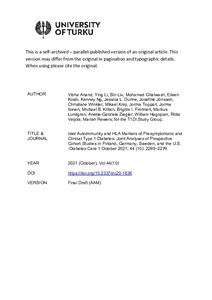Islet Autoimmunity and HLA Markers of Presymptomatic and Clinical Type 1 Diabetes: Joint Analyses of Prospective Cohort Studies in Finland, Germany, Sweden, and the US
Anand Vibha; Li Ying; Liu Bin; Ghalwash Mohamed; Koski Eileen; Ng Kenney; Dunne Jessica L.; Jonsson Josefine; Winkler Christiane; Knip Mikael; Toppari Jorma; Ilonen Jorma; Killian Michael B.; Frohnert Brigitte I.; Lundgren Markus; Ziegler Anette-Gabriele; Hagopian William; Veijola Riitta; Rewers Marian; T1DI Study Group
https://urn.fi/URN:NBN:fi-fe2022022120306
Tiivistelmä
OBJECTIVE
To combine prospective cohort studies, by including HLA harmonization, and estimate risk of islet autoimmunity and progression to clinical diabetes.
RESEARCH DESIGN AND METHODS
For prospective cohorts in Finland, Germany, Sweden, and the U.S., 24,662 children at increased genetic risk for development of islet autoantibodies and type 1 diabetes have been followed. Following harmonization, the outcomes were analyzed in 16,709 infants-toddlers enrolled by age 2.5 years.
RESULTS
In the infant-toddler cohort, 1,413 (8.5%) developed at least one autoantibody confirmed at two or more consecutive visits (seroconversion), 865 (5%) developed multiple autoantibodies, and 655 (4%) progressed to diabetes. The 15-year cumulative incidence of diabetes varied in children with one, two, or three autoantibodies at seroconversion: 45% (95% CI 40–52), 85% (78–90), and 92% (85–97), respectively. Among those with a single autoantibody, status 2 years after seroconversion predicted diabetes risk: 12% (10–25) if reverting to autoantibody negative, 30% (20–40) if retaining a single autoantibody, and 82% (80–95) if developing multiple autoantibodies. HLA-DR-DQ affected the risk of confirmed seroconversion and progression to diabetes in children with stable single-autoantibody status. Their 15-year diabetes incidence for higher- versus lower-risk genotypes was 40% (28–50) vs. 12% (5–38). The rate of progression to diabetes was inversely related to age at development of multiple autoantibodies, ranging from 20% per year to 6% per year in children developing multipositivity in ≤2 years or >7.4 years, respectively.
CONCLUSIONS
The number of islet autoantibodies at seroconversion reliably predicts 15-year type 1 diabetes risk. In children retaining a single autoantibody, HLA-DR-DQ genotypes can further refine risk of progression.
Kokoelmat
- Rinnakkaistallenteet [27094]
